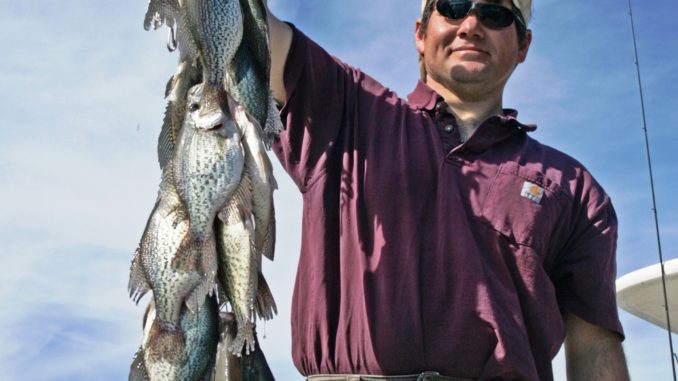
Brush piles are key in mid-lake and upper lake areas; depth is the difference
Catching limits of big crappie may not be an August tradition for everyone, but if you know where to look and what to do, they are ripe for the taking at Lake Murray. Guide Brad Taylor said fishing is usually consistent throughout the summer, and it’s actually a great time to catch a lot of crappie.
“Right now, there are two very distinct patterns that I know of on Lake Murray,” Taylor said. “One is taking place in the mid-lake sector, around the Dreher Island area as a central point, and the other is far uplake where the two rivers join and even above that. The biggest different in the two is the depth you’ll need to fish.”
Taylor said in the mid-lake area, a very definable thermocline has set up around 20 feet deep, and fishermen working brushpiles that are in 20 to 30 feet of water are making excellent catches.
“As far as I’m concerned, for catching crappie in August, it’s all about the depth,” he said. “In the mid-lake area, the magic depth for brush piles is 20 feet or deeper, and the crappie will be suspending above that brush in 15 to 20 feet of water. The crappie will hover right over the brush, but not in it, if you get out early or late or fish on a cloudy day. On really bright days during the mid-day, the crappies will often be more difficult to catch and will retreat to heavy brush where they’re hard to get to without snagging. But by fishing early and late or having a cloudy day, these fish are very predictable, and you can catch a limit of quality fish and have great deal of confidence that they’ll be plenty on the same pattern again tomorrow. This pattern will last for a few more weeks until the water temperature really begins to drop.”
Taylor (803-331-1354) said that the fish can be caught with either jigs or minnows, but he typically uses minnows, hooking them in the tail because the bait will impart better action.
Taylor said the pattern that’s being fished well up the lake is shallower, probably around 12 feet deep.
“Up in the rivers, we are catching crappie in fairly shallow water most of the time – and sometimes very shallow if you get there at the right time of day,” Taylor said. “Way up the lake, the thermocline is usually not a factor, and the brush piles, fallen trees or any woody cover in 12-to 20-foot depths will hold crappie. But the good thing here is that crappie will often suspend above the cover, so we’re catching them in water from 3 to 10 feet deep. Again, low-light conditions are best for the shallow water action.”
“Sometimes I do have to fish right in the midst of the brush, but usually I can work around the edges and over the top for suspended fish and catch plenty,” Taylor said. “The crappie fishing is excellent and often we’ll catch limits quickly at this time of the year.”


Be the first to comment